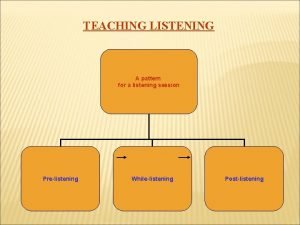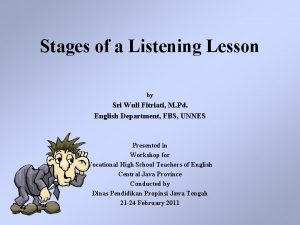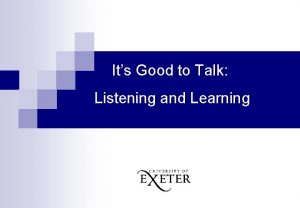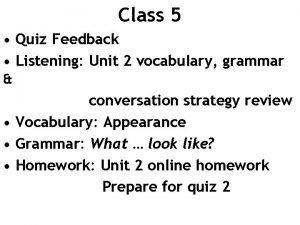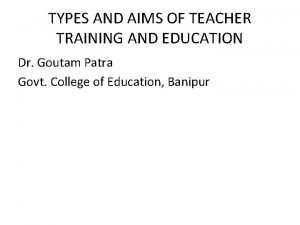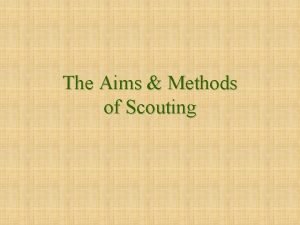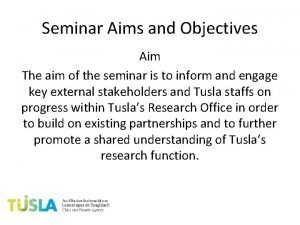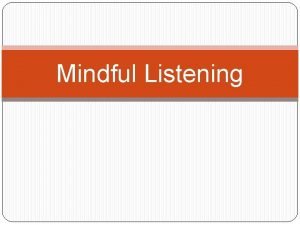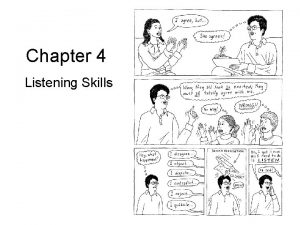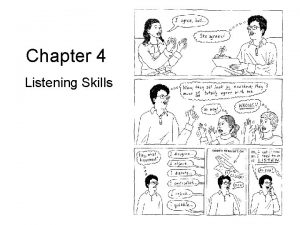Unit 9 Teaching Listening Teaching Aims o o





































- Slides: 37

Unit 9 Teaching Listening

Teaching Aims: o o 1. Listening problems and English situations 2. The characteristics of the listening process 3. The principles and models of teaching listening 4. The common activities in teaching English

1. Some purposes for listening are to: n n n n n gather knowledge and information follow directions participate in discussion interpret and analyze information form an opinion or make a judgement appreciate or enjoy clarify ideas share ideas, feelings, and information state the main idea/theme and identify supporting details determine what is fact and what is opinion select descriptive vocabulary

Why teach listening? (Harmer, 1998: 97 -98) o o o Let students hear different varieties and accents rather than just the voice of the teacher. Help students to acquire language subconsciously even if teachers do not draw attention to its special features. Help them to be better listeners.

Learner problems in listening (Ur, 1996: 111 -112) o o o 1. Trouble with sounds 2. Have to understand every word 3. Cannot understand fast, natural native speech 4. Need to hear things more than once 5. Find it difficult to keep up 6. Get tired if too long

Why is listening often neglected in language teaching? o o o 1. Lack of teaching materials; 2. Lack of equipment; 3. Lack of training in how to use the equipment; 4. Listening is not included on many important tests; 5. Lack of real-life situations where language learners need to understand spoken English; 6. Lesson tends to test rather than train students’ listening skills.

What is special about listening? --difficulties presented by the text (Harmer, 1998: 98 -99) o o 1. Tapes do at the same speed for everyone. Listeners to a tape cannot flick back to a previous paragraph. 2. Listening materials include different dialects and accents, background noises, the use of incomplete utterances, repetitions, hesitations, etc.

2. The Challenge of Teaching Listening Skills o o o successful listening skills are acquired over time and with lots of practice. there are no rules as in grammar teaching. The key is to convince them that not understanding is OK.

3. What is Listening? o o o o 1) Listening is interactive. watching a comedy, we laugh; listening to a lecture, we process and evaluate the information it contains; engaging in conversation, we reply. 2) The most effective listening is active. 3) Listening is closely related to the other skills, particularly speaking. 4) Listening involves a purpose.

Characteristics of the listening process (P 139) o o o Spontaneity Context Visual clues Listener’s response Speaker’s adjustment

Factors influencing listening comprehension: (王笃勤, 2002: 115) o o o o o 1. 2. 3. 4. 5. 6. 7. 8. 9. Automatization of phonetic-decoding Lack of vocabulary Unfamiliar idioms and phrases Types of listening materials Authenticity of listening materials Listening skills Interests of the learners Background knowledge Listening strategies

What kind of listening should students do? (Harmer, 1998: 98) o o o Authentic vs. artificial but realistic Factors considering: 1) the student level (beginning, intermediate, advanced) 2) the interest of the material (comprehensibility, length) 3) the kinds of tasks

Principles for teaching listening o o o o 1. 2. 3. 4. Focus on process Combine listening with other skills Focus on the comprehension of meaning Grade difficulty level appropriately 1) type of language used 2) task or purpose in listening 3) context in which the listening occurs Task 5 (p. 140)

Principles of teaching listening o o Activation of the Active Process Goal-oriented Comprehension-oriented An Integration of Listening and Speaking

Principles (shortened form) for selecting and using activities (Oxford 1993: 210) (p 141) o o o o The activities must have a real, communicative purpose. The activities must use authentic language normally used in everyday life. Pre-reading-tasks must be used to stimulate the appropriate background knowledge & help Ss identify the purpose of the listening activity. The content is personally interesting and motivating. The speaker must be visible whenever possible. The activities must offer many environmental clues to meaning. The whole text should be given, and then divided into parts that can be repeated.

Principles (shortened form) for selecting and using activities (Oxford 1993: 210) (p 141) o o o At the end, the text should be given again, and the Ss should have the opportunity to discuss their hypotheses and so on. The activities must require listeners to respond in some meaningful fashion. The activities must be fashioned for listeners with normal knowledge to be able to understand the topic. The text must be typical for its own speech type. The classroom climate must be non-threatening and positive, and simple affective strategies should be used to reduce anxiety if any.

Principles behind the teaching of listening (Harmer, 1998: 99 -100) o o o 1. The tape recorder is just as important as the tape 2. Preparation is vital 3. Once will not be enough 4. Students should be encouraged to respond to the content of a listening, not just to the language 5. Different listening stages demand different listening tasks 6. Good teachers exploit listening texts to the full

4. The Nature of the Listening Process and the Listening Class o top-down and bottom-up processing operate simultaneously in the listening process (Anderson & Lynch, 1988; ) ----Interactive model

top bottom

a. The bottom-up process o o listening is a process of decoding the sounds that one hears in a linear fashion, from the smallest meaningful units to complete texts phonemic units are decoded and linked together to form words, words are linked together to form phrases, phrases are linked together to form utterances, and utterances are linked together to form complete meaningful texts

b. The top-down process o o the listener actively constructs the original meaning of the speaker using incoming sounds as clues. the listener uses prior knowledge of the context and situation within which the listening takes place to make sense of what he or she hears

5. Listening Strategies o Listening strategies are techniques or activities that contribute directly to the comprehension and recall of listening input.

o o o Top-down strategies are listener based; the listener taps into background knowledge of the topic, the situation or context, the type of text, and the language. listening for the main idea predicting drawing inferences summarizing

o o Bottom-up strategies are text based; the listener relies on the language in the message, that is, the combination of sounds, words, and grammar that creates meaning. Bottom-up strategies include listening for specific details recognizing cognates recognizing word-order patterns

Some other listening strategies o o o o Identify the purpose for listening. Maintain eye contact with the speaker. Observe and interpret non-verbal clues such as tone of voice, gestures and facial expressions. Pay attention to audio-visual aids such as filmstrips, cassettes, maps and charts. Focus on key words or phrases. Tune out other sounds and noise Relate the information currently being given to what you know from earlier learning.

6. Classroom Model of Teaching Listening Pre-listening activities While-listening activities After-listening activities

Pre-listening: Setting the Stage o o o To spark interest and motivate students to attend to the spoken message: To activate or build students' prior topical and linguistic knowledge: To set purposes for listening:

While-Listening: Interpreting Speech and Constructing Meaning o o o To foster students' comprehension of the speaker's language and ideas: To focus students' attention on such things as the speaker's organizational patterns: To encourage students' critical reactions and personal responses to the speaker's ideas and use of language:

Post-listening: Responding, Reflecting, and Reconstructing Understanding o o o To examine relationships between prior knowledge and experience, and new ideas and information gained from the speaker or discussion To invite and encourage student reflection and response: To clarify and extend comprehension beyond the literal level to the interpretive and critical levels

listening Class Pre-listening activities • Introduction • Title guessing • Questions • Discussions • Key words • Visual aids While-listening activities Post-listening activities • Syntactic problems • Discourse problems • Social problems • Cultural problems • Listening Strategies • Writing or reading activities • Comprehension check-up • Oral reproduction • Written reproduction • Outside listening • Testing

listening Class Activities for Pre-Listening Stage • Predict • Activate topic-related words • Set the frame • Tell true or false • Listen for a gist Activities for While-Listening Stage • Listen and tick • Listen and fill • Listen and sequence • Listen and locate • Listen and repeat • Answer multiple-choice questions • Answer closed-ended or open-ended questions • Dictation Activities for Post-Listening Stage • Note-taking and gapfilling • Answer open-ended questions • Reconstruct or summarize the passage • Do a role-play • Write on the same theme

Pre-listening activities

Pre-listening activities

Pre-listening activities

While-listening activities

Further suggestions: confidence (Hedge, 2000: 253) o o o o 1. Grade the listening tasks effectively in class 1) the speaker: number of speakers, speed, accent, etc. 2) the content of the text: formality of the structure, prior knowledge 3) the listener: degree of motivation, degree of response required 4) degree of support given to listeners 2. Exposure to English outside the classroom 3. Radio and TV programs, English songs, etc.

Questions: o o o 1. What are the principles for teaching listening? 2. From you experience what factors should be taken into consideration when a teacher is designing a listening activity? 3. Find one piece of listening material at your hand try to write out a lesson plan. Please refer to the stages and activities in teaching listening that are mentioned in this lecture.
 Pre while post listening
Pre while post listening Pre listening stage
Pre listening stage Listening aims
Listening aims Active listening passive listening
Active listening passive listening Critical listening
Critical listening Reading aims
Reading aims Aims of foreign language teaching
Aims of foreign language teaching Distant goal meaning
Distant goal meaning Aims and objectives of teaching economics
Aims and objectives of teaching economics Aims of teaching literature
Aims of teaching literature What is the objective of microteaching
What is the objective of microteaching Teaching aims and objectives examples
Teaching aims and objectives examples Aims and objectives of language teaching
Aims and objectives of language teaching Top down processing in listening
Top down processing in listening Unit 10, unit 10 review tests, unit 10 general test
Unit 10, unit 10 review tests, unit 10 general test Unit 2 quiz: listening comprehension
Unit 2 quiz: listening comprehension Unit 15 quiz listening comprehension
Unit 15 quiz listening comprehension Unit 12
Unit 12 Unit 11 listening
Unit 11 listening Difference between microteaching and traditional teaching
Difference between microteaching and traditional teaching Project method of teaching
Project method of teaching Good specific aims examples
Good specific aims examples Advantages and disadvantages of aims and objectives
Advantages and disadvantages of aims and objectives Cvit sia licence
Cvit sia licence Aims and objectives of unemployment
Aims and objectives of unemployment Aims of teacher
Aims of teacher Duties of a treasure
Duties of a treasure Method of scouting
Method of scouting The stamus company's hierarchy of aims
The stamus company's hierarchy of aims Jamasoft
Jamasoft Examples of aims
Examples of aims Defects of curriculum
Defects of curriculum Objectives of school health programme
Objectives of school health programme Graphic organizer with the aims of la liga filipina
Graphic organizer with the aims of la liga filipina Aims of health psychology
Aims of health psychology Mru medication authority
Mru medication authority Write any two aims of allocation of industrial estate
Write any two aims of allocation of industrial estate Kahoot marketing mix
Kahoot marketing mix
